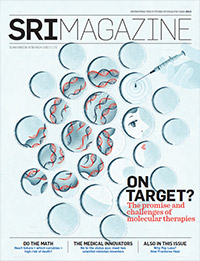Features
Messages
Digest
Short Stories
Ask a Scientist
What Are You Reading Outside of Work and Why?
Three brain scientists at Sunnybrook Research Institute reveal the books they pick up when they put their journal articles down
Edited by Stephanie Roberts
Dr. Ben Goldstein
I just started American Pastoral by Philip Roth, having previously enjoyed several of his books. I have a short attention span for non-work reading, but Roth gets his books up to speed within a few pages, and it's easy to stay interested throughout. I enjoy his punchy sentences that say a lot using few words. Maybe I admire his ability to share ideas so efficiently because this is such a valued attribute in scientific writing. Roth has an amazing ability to convey the perspectives of his characters, portraying their flaws and turmoil without judgment. As a psychiatrist, I appreciate his multifaceted portrayal of characters, blemishes and all, and the recurrent theme in his work that we are all human, fallible, imperfect and deserving of acceptance.
Dr. Goldstein is studying bipolar disorder in teenagers. He wants to identify biomarkers to help inform clinical treatment. In one study, he leads a team of researchers who are investigating if specific markers in the blood can provide a better understanding of mood symptoms and the greater risk of heart disease in teens with bipolar disorder.
Dr. Peggy Richter
What Disturbs Our Blood by James FitzGerald is a fascinating journey into 20th-century medicine in Toronto. It chronicles the story of three generations of FitzGeralds, as told by James, son of physician Jack and grandson of medical pioneer Gerald, whose story is grand: founder of Connaught Labs and pioneer in public health and hygiene; creator of mass immunization programs for diphtheria, typhoid and other diseases; and partner in manufacturing his friends' Banting and Best's newly discovered insulin. Son Jack makes contributions in the emerging fields of allergy and immunology. James also tells a compelling story of the family's multigenerational struggle with depression and suicide, and the emotional fallout he struggles with. I picked up the book expecting to find a medical history of Toronto, but was also drawn in by the sad psychopathology. Mental illness was hushed up then, and this story of the fathers of psychiatry in this city, and their struggles with limited or damaging biological treatments, strongly resonated with me.
Dr. Richter is studying the genetic and biological basis of obsessive-compulsive disorder, and working to improve treatment outcomes for this and related disorders. She leads the Frederick W. Thompson Anxiety Disorders Clinic, founded in 2012 by a $10-million donation.
Dr. Bojana Stefanovic
I recently read Daniel Kahneman's Thinking Fast and Slow on the failings of the human mind from the psychological perspective. I am ambivalent about psychology, but I enjoy stealing books from my husband, which is how I picked this one up. It's a fascinating work, starting from the incredibly understated tone of this great thinker. He ascribes much of the theoretical work that led to his Nobel Prize to his long-term collaboration with Amos Tversky and their daily, conversation-based approach to research. It's hard to read this book and not feel more (slow) thinking would propel us all. He coins an abbreviation so awkward that it stuck with me: WYSIATI, "What you see is all there is." While it's clear that this visionary, like many others, would not have survived in sales, WYSIATI is a great mnemonic to remind yourself of the importance of deliberation and perspective shifting.
Dr. Stefanovic is developing new methods for imaging brain function. In one project, she is looking at changes that occur in the brain's neurons and blood vessels after a stroke. Her aim is to understand how such changes support rehabilitation, toward guiding the creation of new treatments for stroke.
Photos: Doug Nicholson



- << Connections |
- Previous: Where Are They Now? •
- Next: Allies in Academia
- |Through the Wormhole >>






